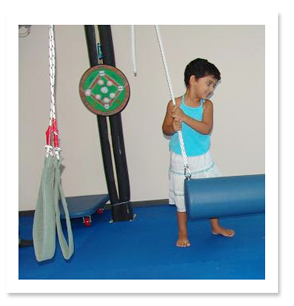Sensory Integration Theory was formed by A. J. Ayers who was an Occupational Therapist with advanced training in Neuroscience and Educational Psychology
She defined Sensory Integration as the neurological process that organizes sensation from one's own body and from the environment and makes it possible to use the body effectively within the environment?
All the information children receive from their environment arrives through the sensory systems. Most of us are familiar with the sense of Smell, Taste, Sight and Sound. There are 3 more senses that we are less aware of and these are: the sense of Touch (the Tactile Sense), the sense of Movement (the Proprioceptive Sense) and the sense of Balance (the Vestibular Sense).

The SI theory puts an emphasis on these 3 important senses:
Tactile system detects qualities and locations of external stimuli applied to the skin. Information from the skin, about location of touch, pain and temperature is transferred through this system to the brain.
Proprioceptive system refers to sensation of movement (i.e. speed, rate, sequencing, timing and force). It's important for the development of body scheme, praxis (motor planning), and adaptive action. The information on proprioception arrives from the muscle receptors and partially from skin receptors which provide to the brain information about muscle change during movement. This allows generation of proper amount of force needed to act on objects.
Vestibular system - the vestibular input contributes to posture and the maintenance of a stable visual field. The receptors for vestibular input are located in the inner ear. There is a combined impact of vestibular and proprioception input on muscle tone, posture, equilibrium, and motor behavior.
Dysfunction in Sensory Integration (DSI)
If one or more of the sensory systems are not fine tuned to work with harmony with the rest, or information from the senses is not well processed the level of functioning of the child might be compromised.
Symptoms that are commonly displayed in DSI include:
- Being overly sensitive to touch, movement sights or sounds
- Being under reactive to sensory stimuli
- High or Low Activity Level
- Coordination problems
- Delays in speech or language skills
- Poor organization of behavior
- A poor self concept
Sensory Integration (SI) Therapy
It is important to do an assessment with the child and interview the parents in order to identify the areas of strengths and weaknesses in order to tailor an individual intervention plan and to create a base line for future intervention.
The SI therapy is being done mainly in a special gym that includes plethora of suspended equipment (swings, ladders, tunnels, therapy balls and many more). The equipment allows us to give a variety of stimulation to all the sensory systems.
|